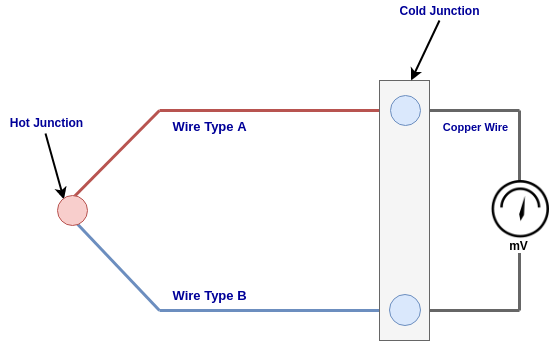A thermocouple is an active transducer that measures temperature. It works on the principle of see back effect. They are extensively used for temperature measurement in industrial applications.
Thermocouple Construction and Types
A thermocouple consists of two different types of metals joined together at one end (hot junction) and terminated at another end (cold junction). When the hot junction is heated or cooled, a voltage created can be correlated back to the temperature.

Theoretically, any pair of dissimilar materials can be used for the construction of a thermocouple. But practically, only a few materials have found useful for measuring temperature. The following table shows common types of thermocouple materials with their temperature range.
| Type | Positive Lead | Negative Lead | Temperature Range |
|---|---|---|---|
| R | Platinum-Rhodium (87% Pt,13% Rh) | Platinum | 0 – 1500 oC |
| S | Platinum-Rhodium (90% Pt, 10% Rh) | Platinum | 0 – 1500 oC |
| K | Chromel (90%Ni, 10% Cr) | Alumel (Ni94Al2Mn3Si) | -200 – 1300 oC |
| E | Chromel (90%Ni, 10% Cr) | Constantan (57% Cu, 43% Ni) | -200 – 1000 oC |
| T | Copper | Constantan (57% Cu, 43% Ni) | -200 – 350 oC |
| J | Iron | Constantan (57% Cu, 43% Ni) | -150 – 750 oC |
Thermocouple Working Principle
The thermocouple works on the principle of see back effect. Thomas Johan Seeback discovered that temperature difference(thermal energy) can produce electrical energy. In a thermocouple, two conductors of different type of metals are connected forming two common junctions. When these two junctions are exposed to two different temperatures, a net thermal emf is produced. The value also depends on the materials used and is proportional to the temperature difference between hot and cold junctions.
The output of a thermocouple can be measured directly by a millivoltmeter. It can be also measured with the help of a dc potentiometer or using amplifiers with an output device.
Advantages of Thermocouple
- Cheaper than resistance thermometers.
- Can measure rapid changes in temperature.
- Wide temperature range.
- Offers good reproducibility.
- Convenient for measuring the temperature at one particular point.
Dis-advantages of Thermocouple
- Lower accuracy.
- The induced emf-temperature characteristics are non-linear.
- Signal amplification is required in many applications.
